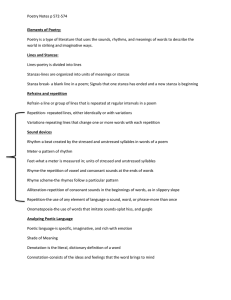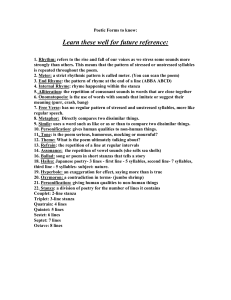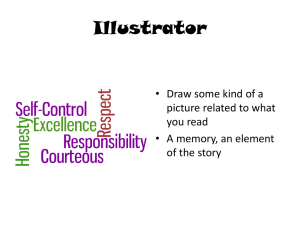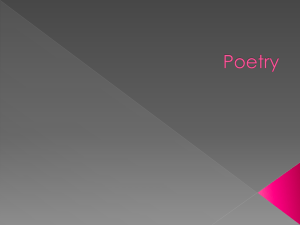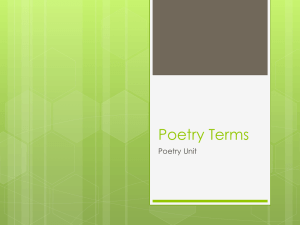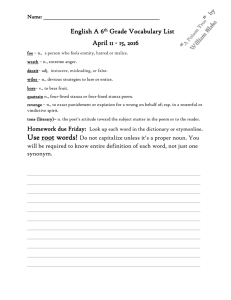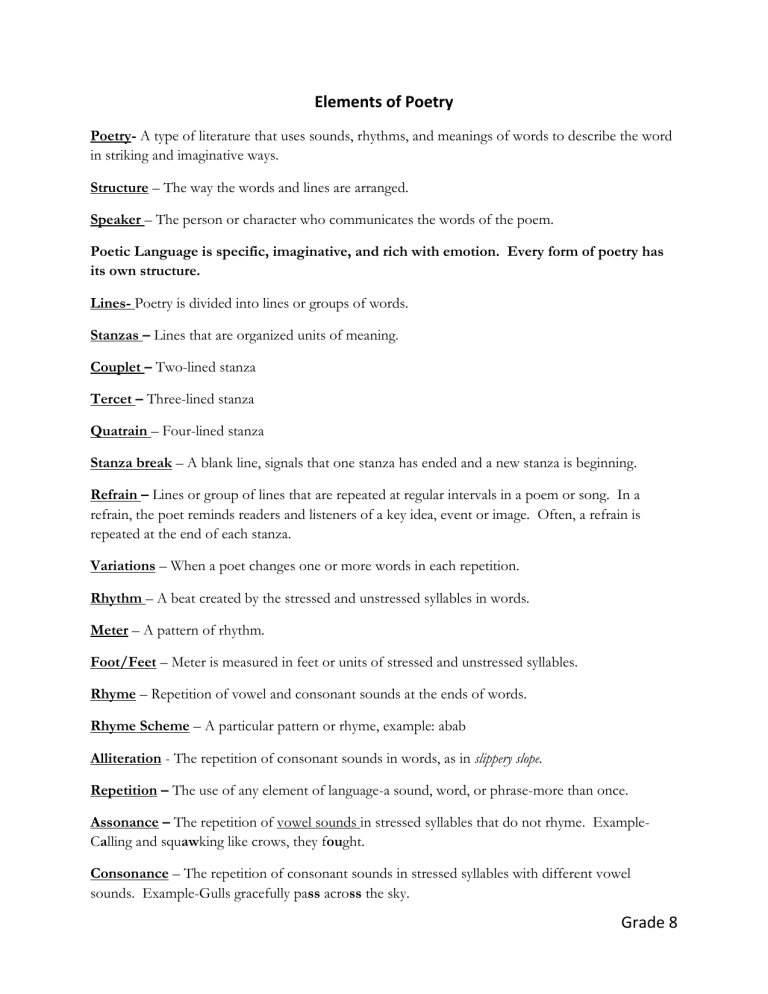
Elements of Poetry Poetry- A type of literature that uses sounds, rhythms, and meanings of words to describe the word in striking and imaginative ways. Structure – The way the words and lines are arranged. Speaker – The person or character who communicates the words of the poem. Poetic Language is specific, imaginative, and rich with emotion. Every form of poetry has its own structure. Lines- Poetry is divided into lines or groups of words. Stanzas – Lines that are organized units of meaning. Couplet – Two-lined stanza Tercet – Three-lined stanza Quatrain – Four-lined stanza Stanza break – A blank line, signals that one stanza has ended and a new stanza is beginning. Refrain – Lines or group of lines that are repeated at regular intervals in a poem or song. In a refrain, the poet reminds readers and listeners of a key idea, event or image. Often, a refrain is repeated at the end of each stanza. Variations – When a poet changes one or more words in each repetition. Rhythm – A beat created by the stressed and unstressed syllables in words. Meter – A pattern of rhythm. Foot/Feet – Meter is measured in feet or units of stressed and unstressed syllables. Rhyme – Repetition of vowel and consonant sounds at the ends of words. Rhyme Scheme – A particular pattern or rhyme, example: abab Alliteration - The repetition of consonant sounds in words, as in slippery slope. Repetition – The use of any element of language-a sound, word, or phrase-more than once. Assonance – The repetition of vowel sounds in stressed syllables that do not rhyme. ExampleCalling and squawking like crows, they fought. Consonance – The repetition of consonant sounds in stressed syllables with different vowel sounds. Example-Gulls gracefully pass across the sky. Grade 8 Onomatopoeia – The use of words that imitate sounds – splat, hiss, gurgle. Denotation – The literal, dictionary definition of a word. Connotation - Ideas and feelings that a word brings to mind. Tone – The attitude the writer projects in a poem. Tone can be determined by word choice and poetic elements that the author uses. Imagery - Descriptions that appeal to the five senses. Imagery helps poets convey what they hear, see, smell, taste, or touch. Literal Meanings – The meanings found in a dictionary. Figurative Language- Language that is not meant to be taken literally. Simile: Uses the word like or as to compare two seemingly unlike things. Ex. His hands were as cold as steel. Metaphor: Describes one thing as if it were something else. Ex. My chores were a mountain waiting to be climbed. Extended Metaphor: Carries a metaphor throughout part or all of a poem. Personification – The writer gives human qualities to a nonhuman subject. Ex. The fingertips of the rain tapped at a steady beat on the windowpane. Analogy – Explains, clarifies, or illustrates by drawing conclusions. Allusions – Direct or implied references to people, places, events, literary works, or artworks. Types of Poetry: 1. Narrative - Poetry that tells a story, contains elements similar to a short story, such as plot and characters 2. Haiku – A three (3)-lined Japanese verse poem. The first and third lines each have fivesyllables and the second line has seven. Describes something in nature. 3. Free Verse – Poetry that does not have a strict structure. It has no regular meter, rhyme, fixed in length, or specific stanza pattern. Grade 8 4. Formal Verse – A poem that follows a fixed, traditional pattern that may include a specific rhyme scheme, meter, line length, or stanza structure. 5. Lyric – Poetry that expresses the thoughts and feelings of a single speaker, often in a musical verse. (song) 6. Ballad – Song that tells a story, often deals with adventure or romance. 7. Epic – A lengthy narrative poem involving a time beyond living memory in which extraordinary men and woman are involved in complicated events. 8. Dramatic Poetry – Presents a drama in verse. The action is told through the words the characters speak. 9. Concrete – Poems that are shaped to look like their subjects. The poet creates a picture on the page. 10. Limericks – Humorous, rhyming. Five-line poems with a specific rhythm pattern and scheme. 11. Rhyming couplet - Pairs of rhyming lines, usually of the same meter and length. 12. Sonnet – A poem that contains fourteen (14) lines. 13. Ode – A lyric poem that praises an important person, place, or thing. 14. Elegy – A lyric poem that expresses sadness over a death or the passing of time. 15. Hymn – A religious song or poem of praise Grade 8


